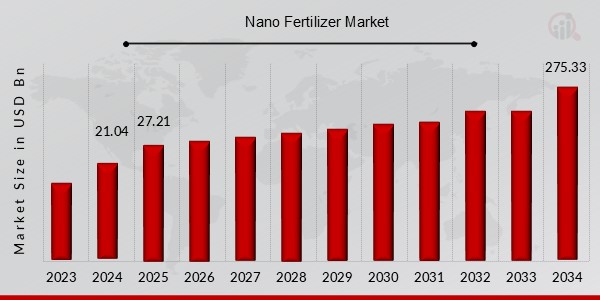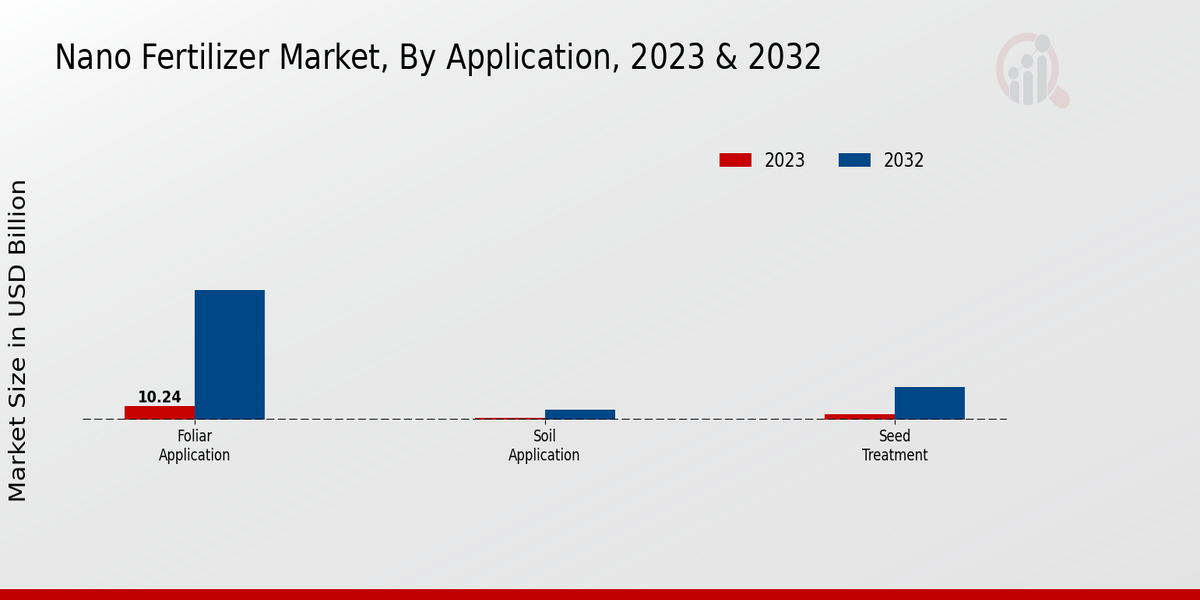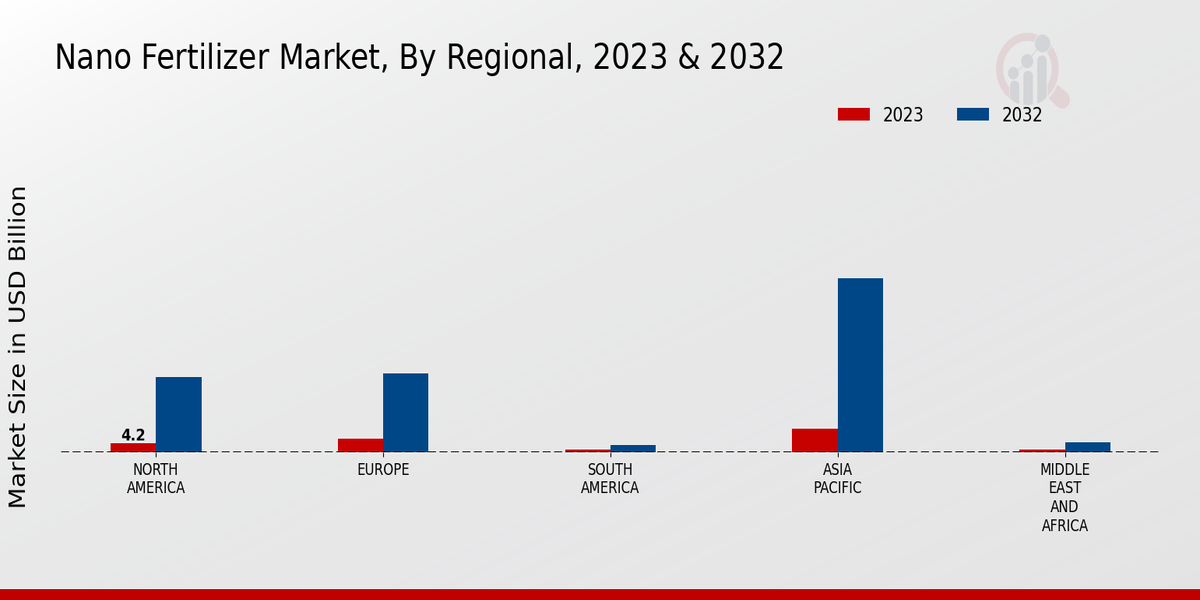Global Nano Fertilizer Market Overview
The Nano Fertilizer Market Size was estimated at 21.04(USD Billion) in 2024.The Nano Fertilizer Industry is expected to grow from 27.21(USD Billion) in 2025 to 275.33(USD Billion) by 2034. The Nano Fertilizer Market CAGR (growth rate) is expected to be around 29.3% during the forecast period (2025 - 2034).
Key Nano Fertilizer Market Trends Highlighted
Important developments in the nano fertilizer market include growing awareness about the advantages of nano fertilizers, market growth owing to government policies supporting eco-friendly agriculture, and rising requirements for high-yield crops. The advancements in nano fertilizers lead to better nutrient application, lower adverse effects on the environment and enhanced crop yield, which accounts for the popularity. All around the world, subsidies and research awards are offered by the governments to help foster the adoption of nano fertilizers for sustainable practice farming. The increased need for high-yield crops to meet the demands of a growing population is also opening great opportunities in the nano fertilizer industry. Further, the market growth is also driven by technical progress in the areas of nano-formulation and targeted delivery systems.

Source: Primary Research, Secondary Research, MRFR Database and Analyst Review
Nano Fertilizer Market Drivers
Increasing Demand for Sustainable and Environmentally Friendly Farming Practices
It is becoming clear that conventional agricultural methods like excessive fertilizer use are harmful. Thus, there is a growing need for green and sustainable options that can replace this way of working. This is where the significance of nano fertilizers, which apply nutrients in an effective and environment-friendly way to the crops, comes in, as there is less environmental pollution and soil erosion. On top of the above initiative, the sustainable development of the farming industry is backed by different combinations of government restrictions and market demand for organic and natural food, which forms a good ground for the spread of nano fertilizers.
Growing Need for Enhancing Crop Yield and Quality
The population is projected to reach 9.7 billion by 2050, leading to an increased demand for food production. Nano fertilizers play a crucial role in addressing this challenge by enhancing crop yield and quality. Their ability to deliver nutrients directly to the plant's root system improves nutrient uptake, leading to increased crop yields. Additionally, nano fertilizers can enhance the nutritional value of crops, providing essential nutrients to consumers.
Government Initiatives and Support for Nanotechnology in Agriculture
Governments worldwide recognize the potential of nanotechnology in revolutionizing agriculture and are implementing initiatives to support research and development in this field. Funding for research projects, tax incentives for companies investing in nanotechnology, and the establishment of dedicated research centers are among the measures taken to foster innovation in the nanofertilizer industry. This support creates a conducive environment for the development and commercialization of nano fertilizers, accelerating their adoption in the Nano Fertilizer Market Industry.
Nano Fertilizer Market Segment Insights
Nano Fertilizer Market Application Insights
The Nano Fertilizer Market is segmented into Foliar Application, Soil Application, Seed Treatment, and Other Applications based on application. Among these, the Foliar Application segment accounted for the largest market share in 2023 and is projected to continue its dominance throughout the forecast period. The growth of this segment can be attributed to the increasing adoption of foliar application methods due to their effectiveness in delivering nutrients directly to the plant leaves, resulting in improved nutrient uptake and crop yield.The Soil Application segment is expected to witness significant growth during the forecast period, owing to the rising demand for nano fertilizers that can improve soil health and nutrient availability. The increasing awareness of the benefits of nano fertilizers in enhancing soil fertility and crop productivity is driving the growth of this segment. The Seed Treatment segment is projected to register a steady growth rate during the forecast period, driven by the growing adoption of nano fertilizers for seed treatment to enhance seed germination, vigor, and resistance to pests and diseases.The use of nano fertilizers in seed treatment helps improve crop establishment and overall yield. Other Applications of nano fertilizers include controlled release, fertigation, and hydroponics. The controlled release segment is expected to grow at a significant pace due to the increasing demand for fertilizers that can provide nutrients to crops over an extended period, reducing the frequency of fertilizer applications. The fertigation segment is also expected to witness growth due to the rising adoption of fertigation systems in precision agriculture.The hydroponics segment is projected to grow steadily, driven by the increasing popularity of hydroponic farming techniques. Overall, the Nano Fertilizer Market is expected to witness robust growth in the coming years, driven by the increasing demand for sustainable and efficient fertilization practices. The growing adoption of nano fertilizers across various applications is expected to fuel the market growth, leading to significant market revenue in the years to come.
Source: Primary Research, Secondary Research, MRFR Database and Analyst Review
Nano Fertilizer Market Crop Type Insights
The Nano Fertilizer Market is segmented by Crop Type into Cereals, Fruits and Vegetables, Oilseeds, Legumes, and Other Crops. The Fruits and Vegetables segment is expected to be the fastest-growing segment, with a CAGR of 31.21% during the forecast period. The Oilseeds segment is expected to account for a significant market share in 2023 and is projected to grow at a CAGR of 28.98% from 2024 to 2032. The Legumes segment is expected to account for a moderate market share in 2023 and is projected to grow at a CAGR of 28.56% from 2024 to 2032.The Other Crops segment is expected to account for a small market share in 2023 and is projected to grow at a CAGR of 27.85% from 2024 to 2032.
Nano Fertilizer Market Form Insights
The Nano Fertilizer Market segmentation by Form includes Liquid, Powder, Granules, and Other Forms. The Liquid segment held the largest market share in 2023 and is expected to continue its dominance during the forecast period. The growth of this segment can be attributed to the ease of application and higher nutrient uptake efficiency of liquid fertilizers. The Powder segment is expected to witness significant growth due to its cost-effectiveness and ease of storage and transportation. The Granules segment is also expected to grow at a steady pace owing to its controlled release properties.Other Forms, such as nano-coated fertilizers and seed treatments, are gaining popularity due to their targeted delivery and improved nutrient utilization. The Nano Fertilizer Market revenue is expected to reach USD 34.2 billion by 2026, exhibiting a CAGR of 24.5% during the forecast period.
Nano Fertilizer Market Active Ingredient Insights
The Nano Fertilizer Market is segmented by Active Ingredient into Nitrogen, Phosphorus, Potassium, and Other Active Ingredients. The Nitrogen segment held the largest market share in 2023 and is expected to continue to dominate the market over the forecast period. The growing demand for nitrogen-based fertilizers to enhance crop yield and quality is driving the growth of this segment. The Phosphorus segment is also expected to witness significant growth over the forecast period due to the increasing demand for phosphorus fertilizers to improve soil fertility and crop productivity.The Potassium segment is expected to grow at a steady pace, driven by the increasing demand for potassium fertilizers to enhance crop resistance to pests and diseases. The Other Active Ingredients segment includes micronutrients such as zinc, iron, and manganese, which are essential for plant growth and development. This segment is expected to witness moderate growth over the forecast period.
Nano Fertilizer Market Packaging Insights
The packaging segment plays a crucial role in the overall growth of the Nano Fertilizer Market. Bottles, bags, drums, and other packaging formats are widely used for storing and transporting nano fertilizers. Bottles offer advantages such as transparency, ease of handling, and protection from external factors, making them a preferred choice for small-scale packaging. Bags, on the other hand, are cost-effective and suitable for bulk packaging of nano fertilizers. Drums provide durability and resistance to chemicals, making them ideal for industrial applications.Other packaging formats, such as specialty coatings and films, are gaining traction due to their ability to enhance shelf life and prevent nutrient loss. The Nano Fertilizer Market revenue from the packaging segment is projected to grow significantly in the coming years, driven by increasing demand for nano fertilizers and the need for efficient and sustainable packaging solutions.
Nano Fertilizer Market Regional Insights
The Nano Fertilizer Market is segmented into North America, Europe, APAC, South America, and MEA. Among these regions, APAC is expected to hold the largest market share in the coming years. The region is home to some of the world's largest agricultural economies, such as China and India. Growing demand for food production, coupled with government initiatives to promote sustainable agriculture, is driving the growth of the nano fertilizer market in APAC. For instance, in 2023, the Indian government launched a program to promote the use of nano fertilizers in the country.The program aims to increase the adoption of nano fertilizers by 50% by 2025. North America and Europe are also expected to witness significant growth in the nano fertilizer market. The regions are home to some of the world's leading agricultural research institutions and have a strong track record of adopting new technologies. The growing awareness of the benefits of nano fertilizers, such as their ability to improve crop yield and reduce environmental impact, is driving the growth of the market in these regions. South America and MEA are expected to witness moderate growth in the nano fertilizer market.The regions have a large agricultural sector, but the adoption of nano fertilizers is still in its early stages. However, growing awareness of the benefits of nano fertilizers, coupled with government initiatives to promote sustainable agriculture, is expected to drive the growth of the market in these regions. 
Source: Primary Research, Secondary Research, MRFR Database and Analyst Review
Nano Fertilizer Market Key Players And Competitive Insights
Major players in the Nano Fertilizer Market industry are constantly striving to develop innovative products and technologies to meet the evolving needs of farmers. Leading Nano Fertilizer Market players are investing heavily in research and development to enhance the efficiency and sustainability of their products. The Nano Fertilizer Market is characterized by intense competition, with major players vying for market share. Key players are adopting various strategies, such as mergers and acquisitions, partnerships, and joint ventures, to expand their presence and strengthen their competitive position. The competitive landscape of the Nano Fertilizer Market is expected to remain dynamic in the coming years, with new entrants and established players continuously seeking opportunities for growth and innovation.A leading company in the Nano Fertilizer Market is Origin Nano. The company is known for its innovative nano-fertilizer products, which are designed to improve nutrient uptake and crop yield. Origin Nano's products are based on its proprietary Nano Chelate Technology (NCT), which allows nutrients to be delivered directly to the plant's roots. The company has a strong presence in North America and Europe, and it is expanding its operations into new markets. Origin Nano is committed to providing farmers with sustainable and cost-effective solutions to improve crop production.Another key player in the Nano Fertilizer Market is Smart Nano Fertilizer. The company specializes in the development and production of high-quality nano-fertilizers. Smart Nano Fertilizer's products are designed to improve crop yield, quality, and resistance to pests and diseases. The company has a strong focus on research and development, and it is continuously developing new and innovative products to meet the needs of farmers. Smart Nano Fertilizer has a presence, with operations in North America, Europe, and Asia. The company is committed to providing farmers with sustainable and cost-effective solutions to improve crop production.
Key Companies in the Nano Fertilizer Market Include
Nano Fertilizer Market Industry Developments
Recent developments in the nano fertilizer market indicate a surge in demand for sustainable and efficient crop nutrition solutions. Governments worldwide are implementing policies to promote eco-friendly farming practices, driving the adoption of nano fertilizers. Key players are focusing on research and development to enhance product efficacy and expand their market presence. Strategic partnerships and acquisitions are shaping the competitive landscape, with companies seeking to gain technological advantages and market share. The market is projected to witness substantial growth over the coming years, driven by increasing agricultural productivity needs and the growing awareness of nano fertilizers' environmental benefits.
Nano Fertilizer Market Segmentation Insights
Nano Fertilizer Market Application Outlook
-
Foliar Application
-
Soil Application
-
Seed Treatment
-
Other Applications
Nano Fertilizer Market Crop Type Outlook
-
Cereals
-
Fruits and Vegetables
-
Oilseeds
-
Legumes
-
Other Crops
Nano Fertilizer Market Form Outlook
-
Liquid
-
Powder
-
Granules
-
Other Forms
Nano Fertilizer Market Active Ingredient Outlook
-
Nitrogen
-
Phosphorus
-
Potassium
-
Other Active Ingredients
Nano Fertilizer Market Packaging Outlook
-
Bottles
-
Bags
-
Drums
-
Other Packaging
Nano Fertilizer Market Regional Outlook
-
North America
-
Europe
-
South America
-
Asia Pacific
-
Middle East and Africa
| Report Attribute/Metric |
Details |
| Market Size 2024 |
21.04 (USD Billion) |
| Market Size 2025 |
27.21(USD Billion) |
| Market Size 2034 |
275.33(USD Billion) |
| Compound Annual Growth Rate (CAGR) |
29.3% (2025 - 2034) |
| Report Coverage |
Revenue Forecast, Competitive Landscape, Growth Factors, and Trends |
| Base Year |
2024 |
| Market Forecast Period |
2025 - 2034 |
| Historical Data |
2020 - 2024 |
| Market Forecast Units |
USD Billion |
| Key Companies Profiled |
CF Industries Holdings, Bayer, Mosaic, Uralkali, OCP Group, K+S Aktiengesellschaft, Potash Corporation of Saskatchewan, EuroChem Group, ICL Group, Yara International, Helm, Nutrien, PhosAgro, BASF, Sinochem International Corporation |
| Segments Covered |
Application, Crop Type, Form, Active Ingredient, Packaging, Regional |
| Key Market Opportunities |
Increasing crop yield Enhanced nutrient uptake Reduced environmental impact Growing demand for organic farming Government initiatives |
| Key Market Dynamics |
Growing demand for sustainable agriculture Advancements in nanotechnology Increasing focus on crop yield optimization Government support for nano-based technologies Rising awareness of benefits of nano fertilizers. |
| Countries Covered |
North America, Europe, APAC, South America, MEA |
Frequently Asked Questions (FAQ) :
The Nano Fertilizer Market is projected to reach a valuation of 21.04 USD Billion by 2034.
The Nano Fertilizer Market is expected to grow at a CAGR of 29.3% from 2025 to 2034.
The Asia-Pacific region is expected to dominate the Nano Fertilizer Market throughout the forecast period.
Key applications of nano fertilizers include targeted nutrient delivery, increased crop yield, and reduced environmental impact.
Key competitors in the Nano Fertilizer Market include BASF, Bayer, and Yara.
Increasing demand for sustainable agricultural practices, rising population growth, and government initiatives are major factors driving the growth of the Nano Fertilizer Market.
Challenges faced by the Nano Fertilizer Market include high production costs, regulatory hurdles, and lack of awareness among farmers.
Nanotechnology has revolutionized the fertilizer industry by enabling the development of nano fertilizers with improved nutrient delivery and reduced environmental impact.
The Nano Fertilizer Market is expected to witness continued growth in the future, driven by increasing demand for sustainable agriculture and technological advancements.
Potential benefits of using nano fertilizers include improved crop yield, reduced environmental impact, and increased nutrient uptake efficiency.
















